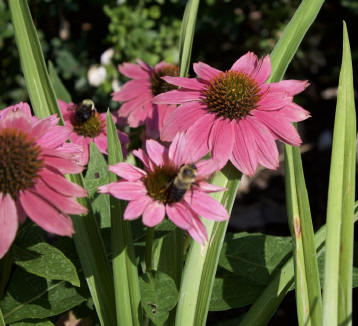
(8/15) Pollinators are not only vitally important to your garden; they are the driving force behind all of nature. Without pollinators, the world as we know it simply could not exist.
Don’t confuse our native pollinators with the garden pests that destroy our roses, garden vegetables and beloved trees. These, generally, are not native. They arrived on our shores by accident mostly in packing material, or undetected on plants.
Pollinators make it possible for a plant to produce a fertilized seed which is the only way that plant can procreate.
As home gardeners, it is important to think in terms of feeding the pollinators all throughout the growing season. That means not just summer, but also very early spring until freezing winter weather.
 The extreme ends of our growing season are critical times for our native pollinators. The best way to help them is to grow a garden that is rich in diversity. This means many different kinds of plants that will offer continuous blooms from February to November.
The extreme ends of our growing season are critical times for our native pollinators. The best way to help them is to grow a garden that is rich in diversity. This means many different kinds of plants that will offer continuous blooms from February to November.
Once spring temperatures begin to reach 50 degrees, and native pollinators emerge from their winter dormancy, it is extremely important for them to find food immediately.
Nature provided for this need by producing ephemerals. These are the beautiful little native flowers that appear in very early spring, usually in woodland settings. Once they complete their mission of feeding early pollinators, they simply disappear until next year.
Native ephemerals don’t usually do well in a typical home landscape, but there are things we can plant that will be beautiful and offer sustenance to pollinators at the same time. Heaths and heathers of the Erica family tend to bloom in the winter months. In general, they are easy to grow; however, they do require acidic soil to thrive.
Small bulbs such as Crocus and Snow Drops (Galanthus) will normally be blooming in February and early March along with Lenten Rose (Hellebores). In early March our native Pussy Willow (Salix discolor) becomes a very important nectar source for pollinators.
Many trees and shrubs begin to bloom in April to fill in the gap between those very early bloomers and May when all the familiar May bloomers kick in.
Most gardeners have no trouble finding plants that bloom from May through August. Just about any flowering plant will attract some pollinators, but try to include as many natives as possible. Our native insects will almost always choose a native plant over a non-native plant when it has a choice, and there are so many good choices.
Native Eastern Red Columbine provides early pollen. Hummingbirds especially look for it when they first arrive in the spring. Coneflowers, (Echinacea purpurea) are loved by most gardeners for their beauty and durability right along with the many different Rudbeckias. Monarda, Garden Phlox, and Blazing Star (Liatris) are three more excellent examples of beautiful
natives to add beauty and attract pollinators to your landscape. Also, try Mountain Mint (Pycnanthemum muticum). Pollinators absolutely love it.
Once we get into fall, many gardens begin to fall short. When it comes to fall color, the first plant on most people’s minds is mums. Pollinators will sometimes nectar on mums, but add a nice cluster of native Asters to your garden, and see for yourself which plant they prefer! I have had New York Asters in my garden for many years, and when they come into bloom, you
can actually hear the buzzing as you approach! It is just an amazing sight!
Goldenrod (Solidago) will accomplish the same purpose. Like milkweed, Goldenrod got itself a bad reputation with home gardeners because the common varieties are not as attractive as we would like them to be, and they tend to be aggressive spreaders. Also, many people confuse Goldenrod with Ragweed (the bane of hay fever sufferers). As George H. W. Bush was fond of
saying, "Read my lips," I tell you, Read my Lips, "Goldenrod Does Not Cause Hayfever!"
There are several varieties of Goldenrod that are much more attractive than the common variety, and that tend to stay where you put them. Try Solidago ‘Fireworks’. It is truly a beautiful addition to your fall garden.
Both Asters and Goldenrod can continue blooming right to frost. If they were the only fall blooming plants you had, you would be doing a lot. But wait. Toad Lilies (Tricyrtis hirta) Brazilian Verbena (Verbena bonariensis) and Moss Verbena (Verbena aristigera,) will all take the frost and keep on churning out the flowers.
There are many small, native trees that are attractive yard trees while feeding lots of pollinators. Think flowering dogwood, serviceberry, spicebush, redbud, sassafras, American witch hazel, blackhaw viburnum, and sweet bay magnolia.
Equally important to pollinators are the flowering shrubs that are also easy to grow and far less labor intensive than perennials. A few very nice native selections for your landscape might include New Jersey Tea, Fothergilla, Buttonbush, Clethera, Ninebark and Chokeberry. All these shrubs support pollinators, which in turn, support songbirds. You may be thinking that
the shrubs offer fruits and berries for the birds, which is true, but they also attract native insects, and insects are the primary food source for baby birds.
Space does not permit me to go into descriptions of these shrubs. It is easy to google the shrub name and find one whose requirements match the space, light, pH and moisture offerings of your space. Think Native!